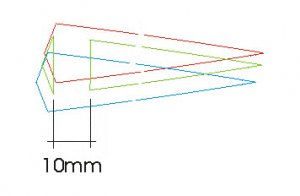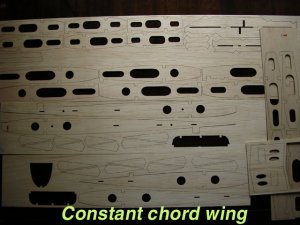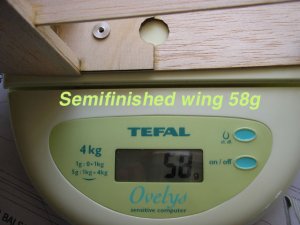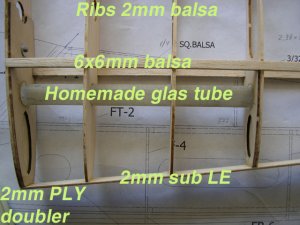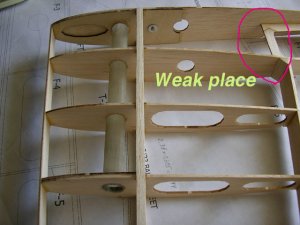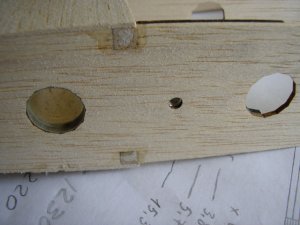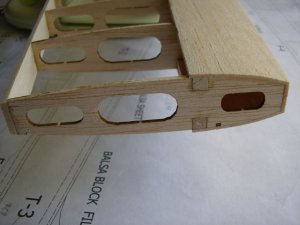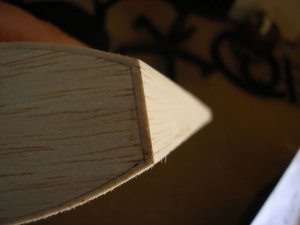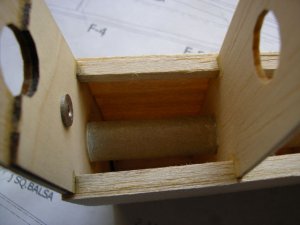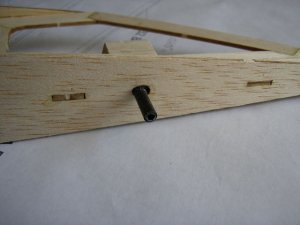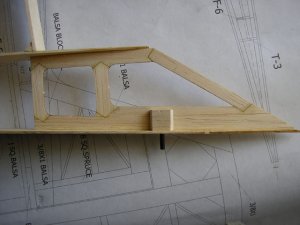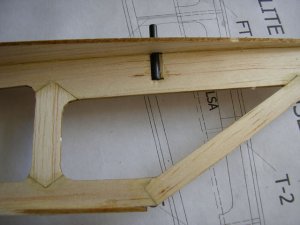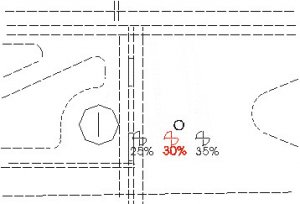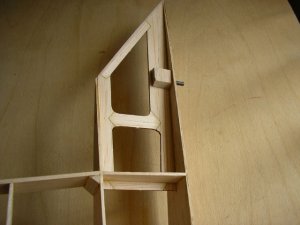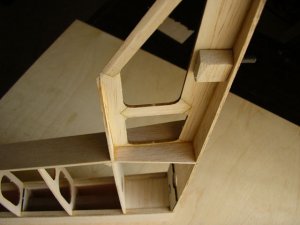Du verwendest einen veralteten Browser. Es ist möglich, dass diese oder andere Websites nicht korrekt angezeigt werden.
Du solltest ein Upgrade durchführen oder einen alternativen Browser verwenden.
Du solltest ein Upgrade durchführen oder einen alternativen Browser verwenden.
Katana
- Ersteller Gerhard_Hanssmann
- Erstellt am
Gerhard
All together on the first photo of a new airplane weighs now about 370 gramme. With 70 gramme aluminium wing tube.
Yes I did the laser cutting.
But not 100 %. Without flat simple details which are easy for cutting a hand.
I can share with you the edited drawings.
I make now both versions of a wing. Classical and constant chord.
By the way what version of drawings you have?
I am going to apply the same components which now in the first Katana.
Hyperion Z3025/08+Titan 50A BEC
Waypoint W150 servo.
3S Li-Po. Now Tronics 4200 3S2P.
But further any easier.
12x6 prop. Now APC E. May be folding prop later or APC Sport. APC E has a flutter at 9000 RPM.
I have now such rpms.
Drawings - Poul Glemba.
All together on the first photo of a new airplane weighs now about 370 gramme. With 70 gramme aluminium wing tube.
Yes I did the laser cutting.
But not 100 %. Without flat simple details which are easy for cutting a hand.
I can share with you the edited drawings.
I make now both versions of a wing. Classical and constant chord.
By the way what version of drawings you have?
I am going to apply the same components which now in the first Katana.
Hyperion Z3025/08+Titan 50A BEC
Waypoint W150 servo.
3S Li-Po. Now Tronics 4200 3S2P.
But further any easier.
12x6 prop. Now APC E. May be folding prop later or APC Sport. APC E has a flutter at 9000 RPM.
I have now such rpms.
Drawings - Poul Glemba.
Zuletzt bearbeitet:
Natürlich. 3 Rippen.Gerhard_Hanssmann schrieb:Viktor,sind zwischen dem Loch für das Querruderhorn 2 Rippen (linkes Bild) ?

Anhänge
Zuletzt bearbeitet:
Gerhard_Hanssmann
User
Viktor, 370 g ist sehr gut. 70 g für den Flächenverbinder ist viel, ich verwende ein CFK Rohr 8 auf 10 mm, ca.62 cm lang. Das reicht, wiegt unter 30 g.
Meine Fläche ist die "classic wing". Diese Fläche ist etwas dicker und damit die Fluggeschwindigkeit niedriger. Vielleicht bau ich später noch die "constant wing"
Viktor und ich bauen nach dem selben Plan von Paul Glemba die Katana.
Respekt vor deine CFK Teilen und den CNC-Teilen.
Welche Spannweite wird deine Katana haben ? AUW ?
Meine Fläche ist die "classic wing". Diese Fläche ist etwas dicker und damit die Fluggeschwindigkeit niedriger. Vielleicht bau ich später noch die "constant wing"
Viktor und ich bauen nach dem selben Plan von Paul Glemba die Katana.
Respekt vor deine CFK Teilen und den CNC-Teilen.
Welche Spannweite wird deine Katana haben ? AUW ?
Woher habt ihr denn diese Pläne, respektive kann mir die jemand schicken?
Würde gerne mal reinschauen!
patrick_nagel33@hotmail.com
Mfg Patrick
Würde gerne mal reinschauen!
patrick_nagel33@hotmail.com
Mfg Patrick
Gerhard
I had a CF tube 15.5mm diameter and 480mm length in Katana I.
Weight only 30 gramme. But I have broken this tube together with a right half of wing in last year's flight incident.
Can be still I shall make a new tube.
Katana I
WS 1.23m
AUW 1650g
520W of power
Weights of a glider only I do not remember, it is necessary to look my recordings.
The same sizes in Katana II.
I had a CF tube 15.5mm diameter and 480mm length in Katana I.
Weight only 30 gramme. But I have broken this tube together with a right half of wing in last year's flight incident.
Can be still I shall make a new tube.
Katana I
WS 1.23m
AUW 1650g
520W of power
Weights of a glider only I do not remember, it is necessary to look my recordings.
The same sizes in Katana II.
It seems about ailerons all clear.
Probably only is required to paste a strip to a trailing edge for a good direct line.
It is possible to go on a wing.
It is not a lot changes from the drawing , basically using easy balsa for light weight.
Probably only is required to paste a strip to a trailing edge for a good direct line.
It is possible to go on a wing.
It is not a lot changes from the drawing , basically using easy balsa for light weight.
Anhänge
Gerhard_Hanssmann
User
Viktor, sehr sauber gebaut.
Schöne und detaillierte Baustufenfotos.
Schöne und detaillierte Baustufenfotos.
Gerhard_Hanssmann
User
Viktor, what do you mean with: «weak place» (red line)
Ich sehe, das 3. Bild. Das ist ein Schwachpunkt.
Ich werde die hintere Endleiste auch von Rippe 2 bis zu Rippe 1 verlängern und zusammen mit der Beplankung oben und unten wird das dann stabil genug.
Ich sehe, das 3. Bild. Das ist ein Schwachpunkt.
Ich werde die hintere Endleiste auch von Rippe 2 bis zu Rippe 1 verlängern und zusammen mit der Beplankung oben und unten wird das dann stabil genug.
Gerhard_Hanssmann
User
Viktor, mein CFK-Flächenverbinder geht von Rippe 1 bis 5 und hat eine Länge von
24 + 13 + 24 cm. 24 cm sind also in einer Flächenhälfte.Der Verbinder überdeckt ca. 38 % der Spannweite. Er wiegt ca. 26 g.
Bei der >>Edge 540 SA>> ist das ähnlich. Hier ist der Durchmesser des CFK Flächenverbinders ca. 8 mm.
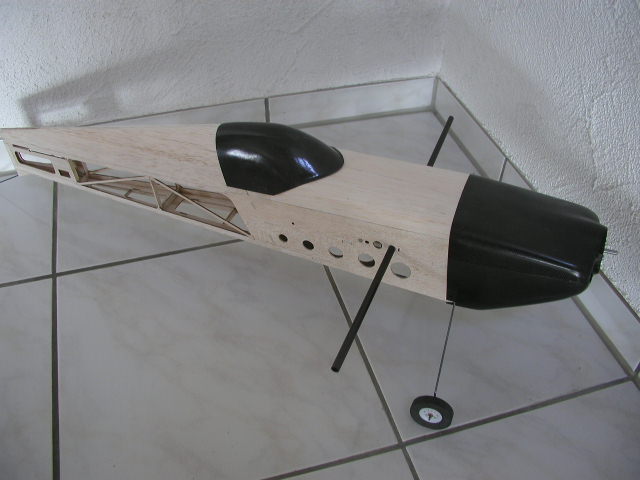
24 + 13 + 24 cm. 24 cm sind also in einer Flächenhälfte.Der Verbinder überdeckt ca. 38 % der Spannweite. Er wiegt ca. 26 g.
Bei der >>Edge 540 SA>> ist das ähnlich. Hier ist der Durchmesser des CFK Flächenverbinders ca. 8 mm.
Gerhard_Hanssmann
User
ViktorF schrieb:Gerhard
I had a CF tube 15.5mm diameter and 480mm length in Katana I.
Weight only 30 gramme. But I have broken this tube together with a right half of wing in last year's flight incident.
Victor, was war der Grund für den Tragflächenbruch ?
Gerhard_Hanssmann schrieb:Viktor, what do you mean with: «weak place» (red line)
Ich sehe, das 3. Bild. Das ist ein Schwachpunkt.
Ich werde die hintere Endleiste auch von Rippe 2 bis zu Rippe 1 verlängern und zusammen mit der Beplankung oben und unten wird das dann stabil genug.
Yes I wanted to speak about it. Fragile.
Probably I too shall add a little balsa there.
Falling from inverted harrier.Gerhard_Hanssmann schrieb:Victor, was war der Grund für den Tragflächenbruch ?
Not controlled corkscrew.
Also I have once fallen from hovering, but fortunately I had a good stock of height.
Also had other problems.
I think they have been connected to back centering. And I could not correct it as all opportunities at that time have ended.
About weight Katana I. I have found my letters.
Uncovered airframe.
Tail group - 48g.
1/2 of wing - 123g.
Fuse - 233g.
Cowl - 40g
Canopy FG - 20g.
LG CF - 40g.
Wing tube - 30g.
Totally 657g.
But it is written totally 693g.
Obviously I have added some details.
OK, 693g uncovered.
Covered airframe 820g.
I think you with your technology receive such weight for 1.40 m WS.
Uncovered airframe.
Tail group - 48g.
1/2 of wing - 123g.
Fuse - 233g.
Cowl - 40g
Canopy FG - 20g.
LG CF - 40g.
Wing tube - 30g.
Totally 657g.
But it is written totally 693g.
Obviously I have added some details.
OK, 693g uncovered.
Covered airframe 820g.
I think you with your technology receive such weight for 1.40 m WS.
Gerhard_Hanssmann
User
@Victor
Der Rohbau meiner Katana sollte unter 700 g zu realisieren sein.
Der Tragflächenbruch ist also nicht Konstruktionsbedingt, sondern durch einen Absturtz bedingt.
Zitat:
"Probably I too shall add a little balsa there."
Das ist eine gute Idee.
Der Rohbau meiner Katana sollte unter 700 g zu realisieren sein.
Der Tragflächenbruch ist also nicht Konstruktionsbedingt, sondern durch einen Absturtz bedingt.
Zitat:
"Probably I too shall add a little balsa there."
Das ist eine gute Idee.
Gerhard, in the first plane I had the centre of gravity as shown in picture and could not do more forward.
In the inverted flight the plane flied to a level without the help of an elevator downwards. It was possible even to release a sticks on the transmitter. I think this critical place of the centre of gravity for the reduced size of the plane.
Also I had other unpleasant thing. If at flight of a constant level I gave a full RIGHT rudder and held him in such position the plane in one instant made the LEFT spiral with loss of height.
Whether can confirm all this a hypothesis of too back centre of gravity?
In the inverted flight the plane flied to a level without the help of an elevator downwards. It was possible even to release a sticks on the transmitter. I think this critical place of the centre of gravity for the reduced size of the plane.
Also I had other unpleasant thing. If at flight of a constant level I gave a full RIGHT rudder and held him in such position the plane in one instant made the LEFT spiral with loss of height.
Whether can confirm all this a hypothesis of too back centre of gravity?
Anhänge
Ähnliche Themen
- Antworten
- 10
- Aufrufe
- 27K
- Antworten
- 0
- Aufrufe
- 8K
- Antworten
- 5
- Aufrufe
- 2K
- Antworten
- 400
- Aufrufe
- 151K

 ) Post them please
) Post them please